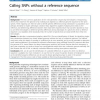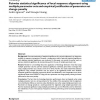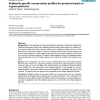11 search results - page 2 / 3 » Comparing sequences without using alignments: application to... |
BMCBI
2010
13 years 5 months ago
2010
Background: The most common application for the next-generation sequencing technologies is resequencing, where short reads from the genome of an individual are aligned to a refere...
CIKM
2008
Springer
13 years 7 months ago
2008
Springer
Background: Accurate estimation of statistical significance of a pairwise alignment is an important problem in sequence comparison. Recently, a comparative study of pairwise stati...
JCB
2000
13 years 5 months ago
2000
Multiple sequence alignments (MSAs) are frequently used in the study of families of protein sequences or DNA/RNA sequences. They are a fundamental tool for the understanding of th...
BMCBI
2007
13 years 5 months ago
2007
Background: Computational methods to predict transcription factor binding sites (TFBS) based on exhaustive algorithms are guaranteed to find the best patterns but are often limite...
BMCBI
2008
13 years 5 months ago
2008
Background: A new algorithm has been developed for generating conservation profiles that reflect the evolutionary history of the subfamily associated with a query sequence. It is ...



